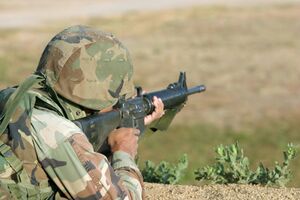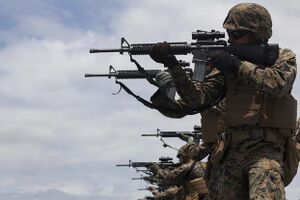Redhawk Firearms M-4 Assault Rifle: Difference between revisions
No edit summary |
No edit summary |
||
| Line 3: | Line 3: | ||
| name = Grady Repeating Arms M-3 Assault Rifle | | name = Grady Repeating Arms M-3 Assault Rifle | ||
| image = File:M16A1 PVS-2.JPEG | | image = File:M16A1 PVS-2.JPEG | ||
| caption = A [[Shenandoahan Army National Guard#Enlisted|Guardsman First Class]] of the [[Shenandoahan Army National Guard]] carrying a Redhawk Firearms M- | | caption = A [[Shenandoahan Army National Guard#Enlisted|Guardsman First Class]] of the [[Shenandoahan Army National Guard]] carrying a Redhawk Firearms M-3 assault rifle equipped with a Silverman Stalker nigh vision device | ||
| type = {{wpl|Assault rifle}} | | type = {{wpl|Assault rifle}} | ||
<!-- Type selection --> | <!-- Type selection --> | ||
Revision as of 18:34, 10 October 2021
This article is incomplete because it is pending further input from participants, or it is a work-in-progress by one author. Please comment on this article's talk page to share your input, comments and questions. Note: To contribute to this article, you may need to seek help from the author(s) of this page. |
| Grady Repeating Arms M-3 Assault Rifle | |
|---|---|
 A Guardsman First Class of the Shenandoahan Army National Guard carrying a Redhawk Firearms M-3 assault rifle equipped with a Silverman Stalker nigh vision device | |
| Type | Assault rifle |
| Place of origin | |
| Service history | |
| In service | 1967 – present |
| Used by | See Operators |
| Production history | |
| Designer | Earl Rock, John Wayne Muncie |
| Designed | 1977 |
| Manufacturer | Redhawk Firearms |
| Produced |
|
| Variants | See Varaints |
| Specifications | |
| Weight |
|
| Length | 39.5 in (1,003 mm) |
| Barrel length |
|
| Cartridge | .243 Grady |
| Action | Gas-operated, rotating bolt |
| Rate of fire | 700-900 rounds/min |
| Muzzle velocity | 3,150 ft/s (960 m/s) |
| Effective firing range | 300 metres (980 ft) |
| Maximum firing range | 550 m (601 yd) |
| Feed system |
|
The Redhawk Firearms M-3 Assault Rifle is a selective fire assault rifle designed by Earl Rock and John Wayne Mauncy between 1977 and 1985. Currently produced by Redhawk Firearms, it is in service with all three branches of the Shenandoahan Army National Guard, but has been largely replaced by the more compact Redhawk Firearms M-3 Carbine.
History and design
The M-3 rifle is a lightweight, air-cooled, gas-operated, magazine-fed assault rifle chambered in .243 Grady. The M-3's receiver is are made from aluminum alloy, its working parts, including the barrel, bolt, and bolt carrier are made of steel, with its furniture, including the handguards, pistol grip, and buttstock from impact resistant polymer.
The weapons action is very similar to that of its predecessor, the Redhawk M-2 Rifle. This internal piston action system designed by Earl Rock is commonly called a direct impingement system. The original M-3 rifle was especially lightweight at 7.9 pounds (3.6 kg) with a loaded 30-round magazine. This was significantly less than the M-2 that it replaced at 10.7 pounds (4.9 kg) with a loaded 20-round magazine. Weight increased with the adoption of the M-3A2, reaching 8.8 lb (4.0 kg) loaded. This increase is owing the the increased thickness of the weapon's barrel at the muzzle to allow for sustained firing without overheating, and to prevent damage to the muzzle and barrel under field conditions.
The original concept surrounding the M-3 magazine was that they were meant to be a lightweight and disposable. As such, it is made of pressed/stamped aluminum and was not designed to be durable. The rifles original 20-round magazines were quickly replaced by a curved 30-round design. Since its introduction, Many magazines, including commercial and aftermarket designs, have been developed to effectively mitigate these shortcomings, including an all-stainless-steel magazine design, and more modernly, polymer magazines. In 1990, the National Guard began fielding an "improved magazine" identified by a tan-colored follower. The new follower incorporates an extended rear leg and modified bullet protrusion for improved round stacking and orientation. The self-leveling/anti-tilt follower minimizes jamming while a wider spring coil profile creates even force distribution. These improvements did not alter the weight of the magazines. As early as 1985, the Shenandoahan National Guard authorized acquisition of commercial magazines by solders for their M-3 riles so long as they were approved for use by the National Guard, allowing soldiers access to these improved magazines. In 2014, this authorization was extended to include non-standard accessories for their weapons, including stocks, vertical foregrips and optical accessories.
Most M-3 rifles have a barrel threaded in 1⁄2-28" threads to incorporate the use of a muzzle device such as a flash suppressor or sound suppressor. The initial flash suppressor design had three tines or prongs and was designed to preserve the shooter's night vision by disrupting the flash. Unfortunately it was prone to breakage and getting entangled in vegetation. The design was later changed to close the end to avoid this and became known as the "bird cage" flash suppressor. Eventually on the M-3A2 version of the rifle, the bottom port was closed to reduce muzzle climb and prevent dust from rising when the rifle was fired in the prone position. In 1984, Grady Repeating Arms introduced a redesigned flash hider for civilian production M-3 rifles, known as the "Cyclone". This muzzle devise, which weighs 3 ounces, is 2.25 inches long, and does not require a lock washer to attach to barrel, proved extremely effective and popular with shooters. In 1987, the National Guard authorized the acquisition of these devices, and brokered a deal between Redhawk and Grady Repeating Arms to allow for the device to become a standard part for the M-3A2 and the in then in development Redhawk Firearms M-3 Carbine. The threaded barrel allows sound suppressors with the same thread pattern to be installed directly to the barrel; however this can result in complications such as being unable to remove the suppressor from the barrel following sustained fire. To resolve this issue, subsequent suppressor designs commonly install over the M-3s muzzle device as opposed to using the barrel's threads.
All current M-3 type rifles, including the M-3 Carbine, can mount under-barrel 40 mm grenade-launchers, such as the M-1 or M-2 Grenade Launcher. T
Variants
M-3
The M-3 was the first version of the rifle adopted operationally. The originally design utilized a triangular handguard, and lacked a storage space in the butt stocks for a rifle cleaning kit. The weapon featured a three position selector switch, including safe, semiautomatic and fully automatic fire. The Shenandoahan Air National Guard continued to operate these weapons until around 2001 with its security forces units, as well as in basic training roles before replacing it with the M-3A2 variant. Some M-3 rifles remain in service as basic training rifles, as well as in use by various law enforcement agencies across the nation.
M-3A2
The M-3A2 was the second operational model of the M-3 rifle series and saw extensive development and reconfiguration, including increased barrel thickness around the muzzle of the weapon to address concerns of warping or bending in field conditions and to allow a longer period of sustained fire without overheating. In addition the design of the flash suppressor with a closed lower section to prevent dirt or snow from being kicked up when the rifle was fired form the prone position and also functions as a recoil compensator. The weapons handguard was modified from the original triangle shape to a rounded shape which made gripping easier, especially for females and soldiers with smaller hands. The new handguards were also symmetrical so armories need not separate left- and right-hand spares, as was required with the original M-3 triangle handguards. A notch for the middle finger was added to the pistol grip, as well as more texture to enhance the grip. In addition, the rifles buttstock was lengthened and its sturdiness increased due to the use of a new polymer compound in its formation, address concerns of warping or cracking under field conditions.
The most substantial modification to the M-3A2 comes in the reworking of the fire control group and the removal of the fully automatic setting. It was discovered during testing and evaluation of infantry activates that, when using a fully automatic weapon, inexperienced troops would often hold down the trigger and "spray" when under fire, expending vast quantities of ammunition without an increase in hit probability. Following a two year long study, the The Shenandoahan Army National Guard concluded that three-shot groups provide an optimum combination of ammunition conservation, accuracy, and firepower. These findings pushed the Army National Guard to advocate for a three-round burst setting to replace the fully automatic setting on the M-3A2. As the primary user of the rifle in combat conditions, this request was granted. Although the M-3A3 was accepted into service in 2009, large quantities of M-3A2 riles remain in service, primarily with the Shenandoahan Coast Guard and Shenandoahan Air National Guard, but also in some reserve units of the Shenandoahan Army National Guard, though the Army National Guard has begun issuing the Redhawk Firearms M-3 Carbine in favor of the larger M-3 Assault Rifle.
M-3A3
The M-3A2 is the newest version of the M-3 rifle family, and was developed to incorporate improvements introduced in versions of the M-3 Carbine favored by units of the Army National Guard. The M-3A3 is equipped with a removable carrying handle and a full length quadaccessory rail for mounting optics and other ancillary devices on the rifle. It retains the safe/semi/3-round bust trigger group of the M-3A2. Although the M-3A3 was accepted into service by the Army National Guard, it is only issued to support and non-combat personnel, with combat units receiving the M-3 Carbine. All M-3A2s are expected to be phased out of the Air Nation Guard and Coast Guard inventories by 2022.
Further updates to the M-3A3 and its accessories have been proposed since its adoption in 2009, including the introduction of a free-floating barrel to increase accuracy. A 2014 study by Redhawk Firearms using several M-3A3 rifles equipped with free-floating barrels suggested accuracy of the rifle could be increased from 4.5 MOA to 2 MOA, considered a significant improvement by the Redhawk testing team. In addition, there has been considerable efforts made to design the reticle of the Silverman Infantry Combat Gunsight from its current chevron design to a more practical semi-circle with center dot style reticle. Other improvements suggested include the addition of ambidextrous charging handles and bolt catch releases for easier use with left-handed shooters, a reconsideration of the current burst fire system, the use of a trigger group with a more consistent pull force, and utilizing the adjustable stock from the M-3 Carbine, allowing for user to adjust the stock length to facilitate better shouldering for smaller individuals and individuals wearing body armor.
Operators
 Shenandoah
Shenandoah
- Shenandoahan National Guard: The Grady Repeating Arms M-3 Assault Rifle has been the standard service rifle of the Shenandoahan National Guard since 1985, with the M-4A3 accepted into service in 2012.


